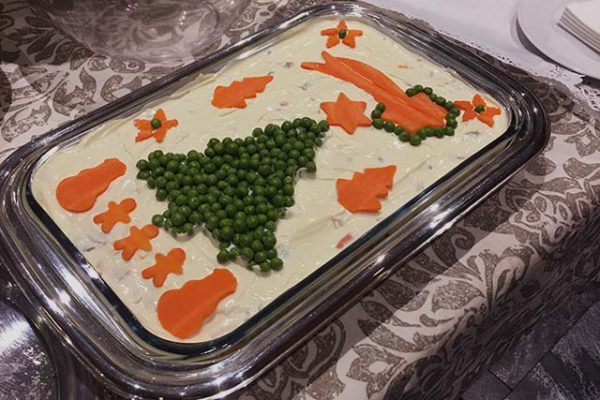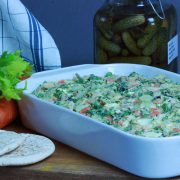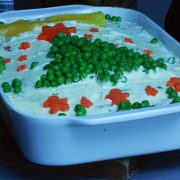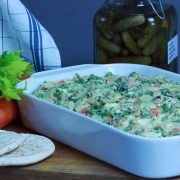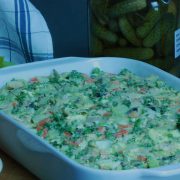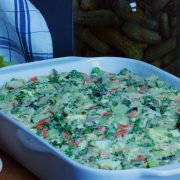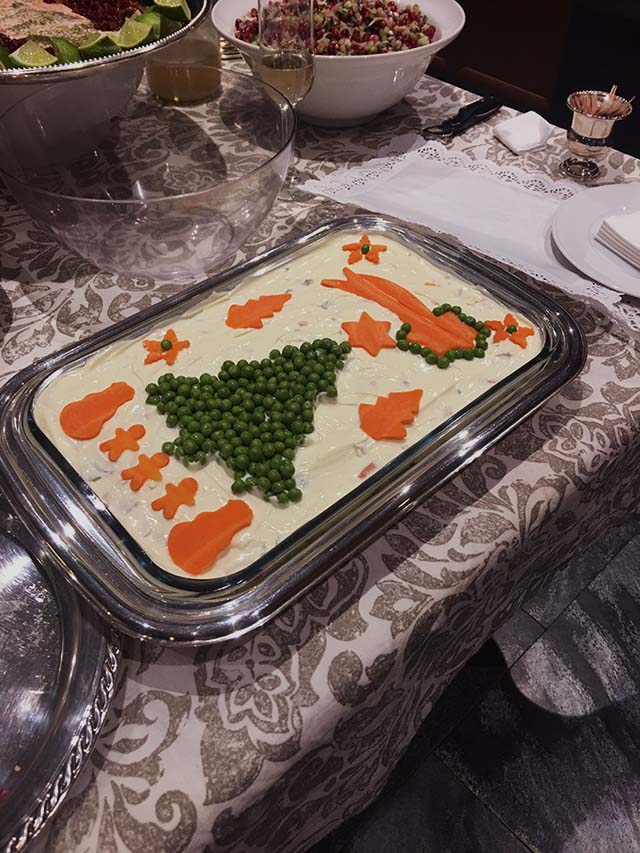Salad Olivier
Russian Salad
Product Description
Olivier salad is a traditional salad dish in Russian cuisine, which is also popular in many other European countries, Iran, Pakistan, Mongolia and also throughout Latin America.. In different modern recipes, it is usually made with diced boiled potatos, carrots, brined dill pickles, green peas, eggs, celeriac, onions, diced boiled chicken (or sometimes ham or bologna sausage), tart apples, with salt, pepper, and mustard added to enhance flavor, dressed with mayonnaise. In many countries, the dish is commonly referred to as Russian salad
The original version of the salad was invented in the 1860s by a cook of Belgian origin, Lucien Olivier, the chef of the Hermitage, one of Moscow’s most celebrated restaurants. Olivier’s salad quickly became immensely popular with Hermitage regulars, and became the restaurant’s signature dish.
The exact recipe — particularly that of the dressing — was a jealously guarded secret, but it is known that the salad contained grouse, veal tongue, caviar, lettuce, crayfish tails, capers and smoked duck, although it is possible that the recipe was varied seasonally. The original Olivier dressing was a type of mayonnaise, made with French wine vinegar, mustard, and Provençal olive oil; its exact recipe, however, remains unknown.
At the turn of the 20th century, one of Olivier’s sous chef’s, Ivan Ivanov, attempted to steal the recipe. While preparing the dressing one evening in solitude, as was his custom, Olivier was suddenly called away on some emergency. Taking advantage of the opportunity, Ivanov sneaked into Olivier’s private kitchen and observed his mise en place, which allowed him to make reasonable assumptions about the recipe of Olivier’s famed dressing. Ivanov then left Olivier’s employ and went to work as a chef for Moskva, a somewhat inferior restaurant, where he began to serve a suspiciously similar salad under the name capital salad “Stolichny”. It was reported by the gourmands of the time, however, that the dressing on the stolichny salad was of a lower quality than Olivier’s, meaning that it was “missing something.”
Later, Ivanov sold the recipe for the salad to various publishing houses, which further contributed to its popularization. Due to the closure of the Hermitage restaurant in 1905, and the Olivier family’s subsequent departure from Russia, the salad could now be referred to as “Olivier.”
One of the first printed recipes for Olivier salad, by Aleksandrova, appearing in 1894, called for half a hazel grouse, two potatoes, one small cucumber (or a large cornichon), 3-4 lettuce leaves, 3 large crayfish tails, 1/4 cup cubed aspic, 1 teaspoon of capers, 3–5 olives, and 1 1⁄2 tablespoon Provençal dressing (mayonnaise).
As often happens with gourmet recipes which become popular, the ingredients that were rare, expensive, seasonal, or difficult to prepare were gradually replaced with cheaper and more readily available foods.
Today’s popular version of Olivier salad — containing boiled potatoes, dill pickles, peas, eggs, carrots, and boiled beef/chicken or bologna, dressed with mayonnaise — is a version of Ivanov’s Stolichny salad, and only faintly resembles Olivier’s original creation. This version was a staple of any Soviet holiday dinner, especially of a Novy God (New Year’s Eve) dinner. Even though more exotic foods are widely available in Russia now, its popularity has hardly diminished: this salad was and maybe still is the most traditional dish for the home New Year celebration for Russian people.
Ingredients
- Chicken
- Potatos
- Carrots
- Peas
- Celery
- Capers
- Olives
- Pickled cucumber
- Mayonais
- Lemon Juice
- Vinegar
- Olive Oil
- Dijon Mustared
- Salt & Pepper
- Chili Pepper

